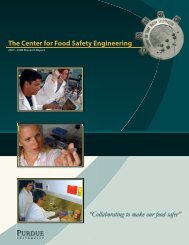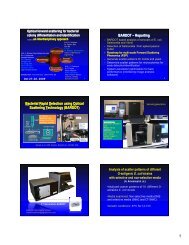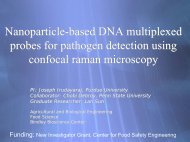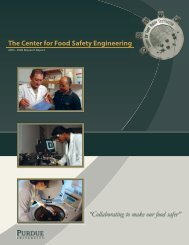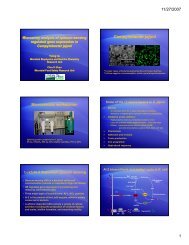Dr. Lihan Huang - Center for Food Safety Engineering - Purdue ...
Dr. Lihan Huang - Center for Food Safety Engineering - Purdue ...
Dr. Lihan Huang - Center for Food Safety Engineering - Purdue ...
You also want an ePaper? Increase the reach of your titles
YUMPU automatically turns print PDFs into web optimized ePapers that Google loves.
ERRC Predictive Microbiology<br />
Toolbox and <strong>Food</strong> <strong>Safety</strong><br />
In<strong>for</strong>mation Gateway<br />
<strong>Lihan</strong> <strong>Huang</strong>, Ph.D<br />
Research Leader<br />
Residue Chemistry and Predictive Microbiology Research Unit<br />
Agricultural<br />
Research<br />
Service
Overview<br />
• Research Unit<br />
• Predictive Microbiology<br />
• Future research and USDA Predictive<br />
Microbiology Tool Box and <strong>Food</strong> <strong>Safety</strong><br />
In<strong>for</strong>mation Gateway
Who we are and what we do<br />
• This unit is a brand new unit and was<br />
<strong>for</strong>med after reorganization in May, 2010.<br />
• I was called to duty on August 1, 2010.<br />
• We have chemists, microbiologists, food<br />
technologists, and engineers.<br />
• Hopefully, we can have a computational<br />
biologist in the future.
The Great Unit of RCPM<br />
• We are a unique group of scientists with diverse expertise<br />
and combined talents to address some of the most<br />
pressing challenges facing the nation’s food supply.<br />
• Together, we strive to conduct both basic and applied<br />
research in science, developing new technologies and<br />
methods to detect chemical residues, predict the fate of<br />
foodborne pathogens, and control their presence in foods.
Four Research Groups<br />
Residue Chemistry<br />
Predictive Microbiology<br />
<strong>for</strong> <strong>Food</strong> <strong>Safety</strong><br />
Integrated Approach to Process<br />
and Package Technologies<br />
Data Acquisition and Modeling<br />
<strong>for</strong> Poultry <strong>Food</strong> <strong>Safety</strong>
Residue Chemistry Group<br />
<strong>Dr</strong>. Steven Lehotay, Investigation in all<br />
aspects of chemical residue analysis.<br />
<strong>Dr</strong>. Marilyn Schneider<br />
Development of methods <strong>for</strong><br />
analysis of veterinary drug<br />
residues in food<br />
Vacant (100 applicants)<br />
Expert in Chromatography and<br />
Mass Spectrometry<br />
<strong>Dr</strong>. Guoying Chen<br />
Application of optical<br />
spectroscopy and other<br />
techniques to rapid food<br />
analysis<br />
<strong>Dr</strong>. Marjorie B. Medina<br />
Development of immunoassay,<br />
biosensor, immunoaffinity, and other<br />
techniques <strong>for</strong> detection of<br />
antioxidants, phytoestrogens, endocrine<br />
disruptors, and pathogen toxins
Predictive Microbiology<br />
<strong>Dr</strong>. Vijay Juneja<br />
<strong>Dr</strong>. Andy Hwang<br />
Predictive Microbiology In<strong>for</strong>mation Portal<br />
Regulations Models Useful Links<br />
• Final Rule on Listeria<br />
monocytogenes in RTE Meat<br />
and Poultry Products<br />
• “Zero Tolerance” Policy<br />
<strong>Dr</strong>. <strong>Lihan</strong> <strong>Huang</strong>
Integrated Approach to <strong>Food</strong> <strong>Safety</strong><br />
<strong>Dr</strong>. Xuetong Fan<br />
Irradiation and produce safety,<br />
chemical, nutritional and quality<br />
changes<br />
<strong>Dr</strong>. Tony Jin<br />
Biopolymers,<br />
antimicrobials, and<br />
food packaging<br />
<strong>Dr</strong>. Sudarsan Mukhopadhyay<br />
Process engineering <strong>for</strong><br />
food safety
<strong>Dr</strong>. Thomas Oscar,<br />
Predictive modeling, risk<br />
analysis and poultry safety<br />
Data Acquisition and Modeling<br />
<strong>for</strong> Poultry <strong>Food</strong> <strong>Safety</strong>
Mathematical Methods and Computer Simulation<br />
in Predictive Microbiology<br />
A fundamental question - how bacteria grow in the eyes of microbiologists<br />
Cytokinesis<br />
Chromosome segregation<br />
Binary fusion<br />
Cell<br />
DNA replication<br />
Chromosome
Binary Fusion
This is an exponential growth process
Modeling Binary Fusion<br />
x(t) = x 0 •2 t<br />
Ln(X) or log 10<br />
(X)<br />
time
The whole world is filled with bacteria!()<br />
If the exponential growth is allowed to proceed<br />
unlimitedly, the whole world may have been<br />
occupied by microorganisms.<br />
Apparently, the nature does not allow unlimited<br />
growth of microorganisms.
The Reality of Bacterial Growth in <strong>Food</strong><br />
A three-phase process, progressing from lag<br />
phase, through exponential phase, to and<br />
stationary phase.<br />
Stationary phase<br />
Log concentration<br />
Lag phase<br />
Exponential phase<br />
time
The Easiest Method<br />
• The “Ruler Method” - used in the “stone age” and in classroom teaching<br />
• Makes great sense in the eyes of microbiologists<br />
Log concentration<br />
time
The Manual Method<br />
• Labor-intensive, slow<br />
• Not suitable <strong>for</strong> large amount of data<br />
• Hard to find a journal to publish your work
Mathematical Modeling<br />
The question is -<br />
Can we use some kind of mathematical<br />
models to describe the bacterial growth<br />
The answer is Yes!
Empirical Models<br />
• Find an equation that resembles growth<br />
curves<br />
• The S-shaped curves<br />
• This approach is primarily used by U.S.<br />
scientists (ARS ERRC) and is the buildingblock<br />
<strong>for</strong> the early versions of the USDA<br />
Pathogen Modeling Program (PMP)
Empirical Models<br />
• Modified Gompertz model<br />
• Modified logistic model<br />
( t) = L + ( L L ) S( t)<br />
L<br />
0 max<br />
!<br />
0<br />
S<br />
( t)<br />
$ exp<br />
!<br />
= #<br />
!<br />
!"<br />
1+<br />
exp<br />
{%<br />
exp[ % µ ( t % M )]<br />
}<br />
1<br />
[%<br />
µ ( t % M )]<br />
Gompertz<br />
Logistic
Kinetic parameters derived from<br />
empirical models<br />
( t) = L + ( L L ) S( t)<br />
L<br />
0 max<br />
!<br />
0<br />
& =<br />
$<br />
!<br />
M<br />
!<br />
#<br />
!<br />
! M<br />
"<br />
%<br />
%<br />
1<br />
µ<br />
2<br />
µ<br />
Gompertz<br />
Logistics<br />
S<br />
( t)<br />
=<br />
$ exp<br />
!<br />
#<br />
!<br />
!"<br />
1+<br />
exp<br />
{%<br />
exp[ % µ ( t % M )]<br />
}<br />
1<br />
[%<br />
µ ( t % M )]<br />
Gompertz<br />
Logistic<br />
K<br />
=<br />
$ L<br />
!<br />
!<br />
#<br />
! L<br />
!<br />
"<br />
max<br />
max<br />
% L<br />
e<br />
% L<br />
4<br />
0<br />
0<br />
µ<br />
µ<br />
Gompertz<br />
Logistic<br />
<strong>Dr</strong>awback<br />
- These are EMPIRICAL models<br />
- Curve-fitting<br />
- Do not tell too much about the nature of bacterial growth
Mechanistic models<br />
The Baranyi Model It was originally based on Michaelis-Menten kinetics<br />
dq<br />
dt<br />
dC<br />
dt<br />
= ( q<br />
=<br />
µ<br />
q &<br />
q<br />
$ '<br />
1+<br />
%<br />
max<br />
1<br />
C<br />
C<br />
y<br />
max<br />
#<br />
! C<br />
"<br />
Formation of critical substances<br />
Logistic equation<br />
max 0 0<br />
( t) = y + ( )'<br />
$ +<br />
! 0<br />
µ<br />
max<br />
A t ln 1<br />
ymax<br />
' y0<br />
% e "<br />
&<br />
e<br />
µ<br />
t'<br />
h<br />
' e<br />
h<br />
#<br />
1 !"<br />
t ! h<br />
( ) ln( )<br />
0 !"<br />
t!<br />
h<br />
= t + e + e ! e<br />
0<br />
A t<br />
"<br />
h<br />
ln ( q %<br />
&<br />
0<br />
1<br />
# !<br />
' q + $<br />
0<br />
0<br />
= " = " ln<br />
( )<br />
0
Primary Models<br />
• These models have been used <strong>for</strong> many<br />
years and appeared in numerous<br />
publications<br />
• Both models are widely used in the U.S.-<br />
based publications<br />
• The Baranyi model is predominantly used<br />
outside the U.S.
Progress from ERRC - A New<br />
Primary Model<br />
• Strictly based on the biological phenomenon that<br />
are observed in the experiments<br />
• Basic definition of lag phase – no change in cell<br />
counts<br />
• Exponential growth – log-linear growth curve<br />
• Stationary phase – no change in cell counts
A New Primary Model from ERRC<br />
dC<br />
dt<br />
) C & 1<br />
= µ C<br />
' 1 #<br />
$<br />
( Cmax<br />
% 1+<br />
exp t<br />
[#<br />
"( # !)]<br />
From lag phase to exponential phase<br />
λ, lag phase
Analytical Solution to the New<br />
Growth Model<br />
y<br />
( t) = y0<br />
+ ymax<br />
# ln{ exp( y0) + [ exp( ymax) # exp( y0)<br />
] exp[ # µ $ exp( ymax) B( t)<br />
]}<br />
,<br />
1 1+<br />
exp<br />
( )<br />
(#<br />
!( t # "<br />
)<br />
B t = t + ln<br />
! 1+<br />
exp( !")<br />
where<br />
10<br />
9<br />
8<br />
log(CFU/g)<br />
7<br />
6<br />
5<br />
4<br />
3<br />
2<br />
0 5 10 15 20 25 30 35 40<br />
t (h)<br />
! = 0.1 ! = 0.5 ! = 1 ! = 25
L. Monocytogenes in BHI Broth (37 o C)<br />
10<br />
log(CFU/ml)<br />
9<br />
8<br />
7<br />
6<br />
5<br />
4<br />
3<br />
2<br />
1<br />
0<br />
Lag phase determined by the new model<br />
0 1 2 3 4 5 6 7 8 9 10 11 12 13 14 15 16 17 18 19 20 21 22 23 24<br />
t (h)<br />
G1 G2 G3 G4 Gompertz Baranyi New model
Special case (no stationary phase)<br />
y<br />
( t)<br />
=<br />
y<br />
0<br />
+<br />
&<br />
µ % t<br />
$<br />
1 1+<br />
exp<br />
+ ln<br />
( 1+<br />
exp<br />
['<br />
(<br />
t ' )<br />
]<br />
(()) ! "#<br />
10<br />
9<br />
8<br />
log(CFU/g)<br />
7<br />
6<br />
5<br />
4<br />
3<br />
2<br />
0 10 20 30 40 50 60 70<br />
t (h)<br />
15°C 30°C 37°C
E. coli O157:H7 in beef<br />
20<br />
Rif r , 25°C<br />
20<br />
Wild, 25°C<br />
18<br />
18<br />
16<br />
16<br />
14<br />
14<br />
12<br />
12<br />
10<br />
10<br />
8<br />
8<br />
Ln cfu/g<br />
6<br />
0 2 4 6 8 10 12 14 16 18 20 22 24 26 28 30 32<br />
6<br />
0 2 4 6 8 10 12 14 16 18 20 22 24 26 28 30 32<br />
20<br />
Rif r , 37°C<br />
20<br />
Wild, 37°C<br />
18<br />
18<br />
16<br />
14<br />
12<br />
10<br />
8<br />
6<br />
0 2 4 6 8 10 12 14 16 18 20 22 24 26<br />
t (h)<br />
16<br />
14<br />
12<br />
10<br />
8<br />
6<br />
0 2 4 6 8 10 12 14 16 18 20 22 24 26<br />
t (h)<br />
Red: <strong>Huang</strong> model<br />
Green: Baranyi<br />
Yellow: Gompertz
The New ERRC Model<br />
• Directly derived from the fundamental<br />
assumptions of bacterial growth<br />
• All three phases clearly identifiable<br />
• The lag phase and exponential growth<br />
explicitly determined<br />
• Accurate
Progress from ERRC – A More Realistic<br />
Secondary Model<br />
Effect of Temperature on Growth Rate<br />
Optimum Temp<br />
Growth Rate<br />
Min Temp<br />
Max Temp<br />
Temperature
Ratkowsky Models<br />
µ<br />
µ<br />
µ =<br />
=<br />
=<br />
a<br />
a<br />
a<br />
( T ! T )<br />
[ ]<br />
[ ]<br />
1!<br />
e<br />
b T ! T<br />
( T ! T ) 1!<br />
e<br />
b( T ! T ) max<br />
( )<br />
2<br />
T ! T<br />
( ) max<br />
min<br />
min<br />
min
Ratkowsky models - Limitations<br />
Optimum Temp<br />
Growth Rate<br />
Ratkowsky model<br />
Min Temp<br />
Real Max Temp<br />
Real Min Temp<br />
Temperature
Progress from ERRC - A More Realistic<br />
Secondary Model<br />
µ =<br />
a<br />
[ ]<br />
( T ! T )"<br />
1!<br />
e<br />
b( T ! T ) max<br />
min
A New Secondary Model from ERRC<br />
L. Monocytogenes in beef hot dogs
What’s next<br />
Our Short Term Goal -<br />
• Develop a software tool<br />
• Primary models<br />
• Secondary models<br />
• PMP – USDA Pathogen Modeling Program<br />
• PMIP – USDA Pathogen Modeling<br />
In<strong>for</strong>mation Portal
Our Long Term Goal - ERRC Predictive<br />
Microbiology Toolbox and <strong>Food</strong> <strong>Safety</strong><br />
In<strong>for</strong>mation Gateway<br />
Computation/<br />
Numerical<br />
Analysis<br />
Engine<br />
Data<br />
Processing<br />
Engine<br />
Database<br />
Engine<br />
Mathematical<br />
Model Engine<br />
Menu Bar<br />
<strong>Food</strong><br />
<strong>Engineering</strong><br />
Engine<br />
Front-End Engine<br />
Documentation<br />
Engine<br />
Report<br />
Engine<br />
System<br />
Update<br />
Engine<br />
Risk Analysis Engine






